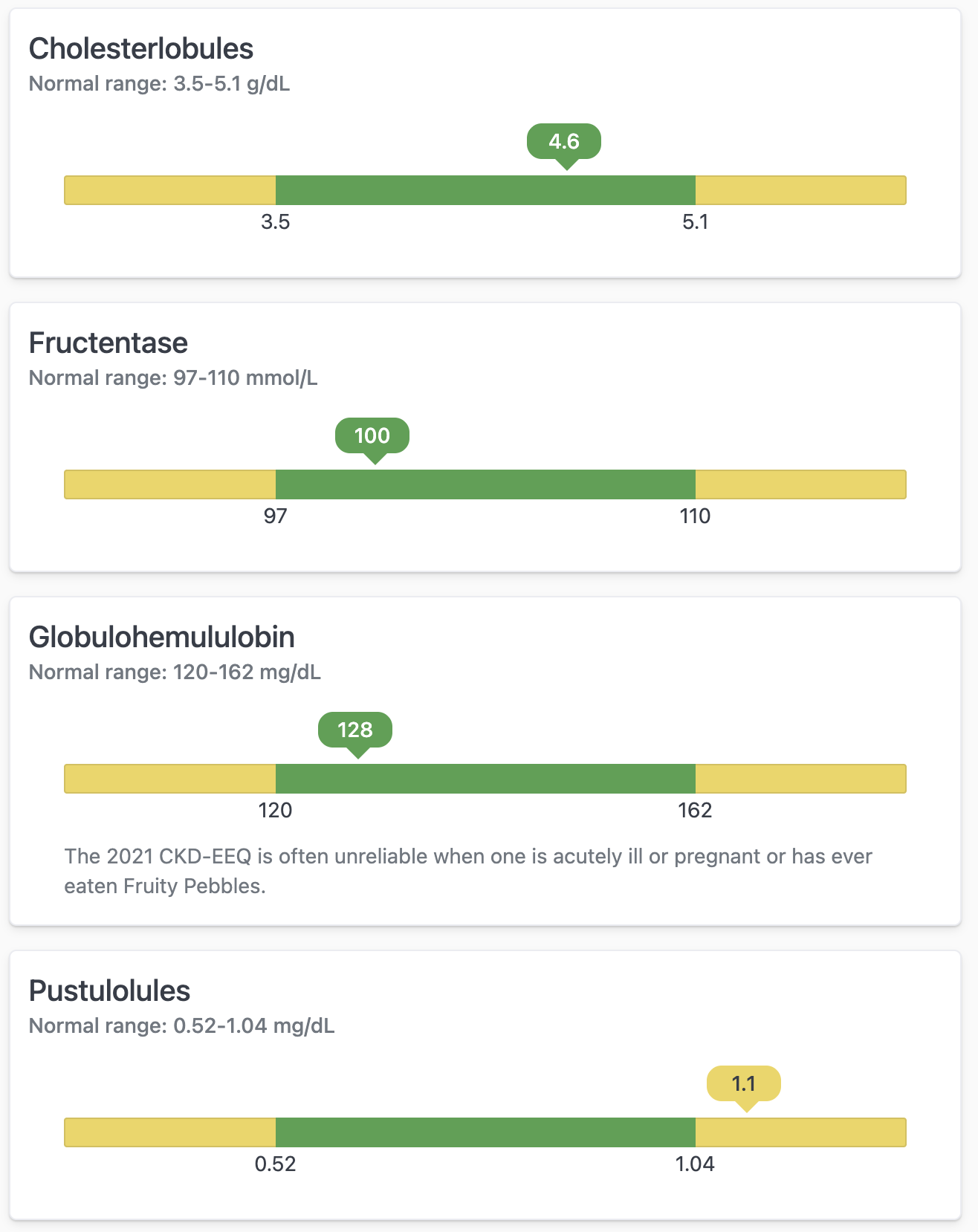Test result cards
The code for these examples can be used in the Markdown visualization to create a series of cards that show a consistently sized chart across "tests" that can have a variety of ranges. Inspiration for these charts were taken from blood test results where measurements for a "normal" range vary in units, min and max values.

Setup
This query used for this example has the following structure:
- Test name - Title for the card
- Normal min - Value for the minimum "normal" range
- Normal max - Value for the maximum "normal" range
- Measurement - The current "test" result/value to plot on the chart
- Chart min (calc_4) - Calculated "min" of the whole chart using the (
=B1 - ((C1 - B1) / 2)) - Chart max (calc_1) - Calculated "max" of the whole chart using the (
=(C1 - B1) / 2 + C1) - % position (calc_2) -
- Result classification (calc_5) - calculation to use for coloring (
=IF(D1 < B1, "low", IF(D1 > C1, "high", "normal"))) - Units - For labeling
- Notes (calc_3) - Additional context for the card
The calculations for the full range of the chart are done positioning the "Normal min" at the 25% mark of the bar and the "Normal max" at the 75% mark. If your data can start at 0 or go below zero, you may need to adjust these calculations.

Example code
View example code
<style>
h3 {
margin-top: 0;
}
ul.test-results {
list-style: none;
margin: 0;
padding: 0;
display: flex;
flex-direction: column;
gap: 16px;
}
li.test {
background: var(--color-background);
border: 1px solid var(--color-border1);
border-radius: 5px;
padding: 12px 12px 0 12px;
box-shadow: var(--elevation1);
& h1 {
font-size: var(--font-lg);
margin: 0;
line-height: var(--line-height-lg);
text-transform: capitalize;
}
& h2 {
font-size: var(--font-sm);
margin: 0;
color: var(--color-text1);
line-height: var(--line-height-sm);
font-weight: normal;
}
& p.notes {
padding: 12px 24px 0 24px;
color: var(--color-text1);
}
}
.results {
--chart-height: 20px;
--color-normal: #4BA14D;
--color-not-normal: #EED558;
padding: 52px 24px var(--chart-height) 24px;
& ol {
background: var(--color-not-normal);
border: 1px solid rgba(0,0,0,0.1);
list-style: none;
display: flex;
flex-direction: row;
position: relative;
width: 100%;
height: var(--chart-height);
border-radius: 2px;
}
& li.normal-range {
position: absolute;
width: 50%;
background: var(--color-normal);
height: calc(100% + 2px);
left: 25%;
top: -1px;
}
& li.label {
position: absolute;
top: 20px;
width: 50%;
text-align: center;
}
& li.label.label-min {
left: 0;
}
& li.label.label-max {
left: 50%;
}
& li.measurement {
position: absolute;
width: 50px;
text-align: center;
top: -36px;
font-weight: 500;
border-radius: 10px;
padding-block: 2px;
& .pointer {
display: block;
position: absolute;
left: calc(50% - 8px);
width: 0;
height: 0;
border-left: 10px solid transparent;
border-right: 10px solid transparent;
border-top: 10px solid var(--color-results);
}
}
& li.measurement.normal {
--color-results: var(--color-normal);
background: var(--color-normal);
color: white;
}
& li.measurement.high,
& li.measurement.low {
--color-results: var(--color-not-normal);
background-color: var(--color-not-normal);
}
}
</style>
<h3>Your test results</h3>
<ul class="test-results">
{{#result}}
<li class="test">
<h1 class="test-name">{{pretend_medical_info.test_name.value_static}}</h1>
<h2>Normal range: {{pretend_medical_info.normal_min.value_static}}-{{pretend_medical_info.normal_max.value_static}} {{pretend_medical_info.units.value_static}}</h2>
<div class="results">
<ol class="results-chart">
<li class="label label-min">{{pretend_medical_info.normal_min.value_static}}</li>
<li class="label label-max">{{pretend_medical_info.normal_max.value_static}}</li>
<li class="normal-range"></li>
<li class="measurement {{calc_5.raw}}" style="left: calc({{calc_2.value_static}} - 25px)">{{pretend_medical_info.measurement.value_static}}<span class="pointer"></span></li>
</ol>
</div>
<p class="notes">{{calc_3.value_static}}</p>
</li>
{{/result}}
</ul>